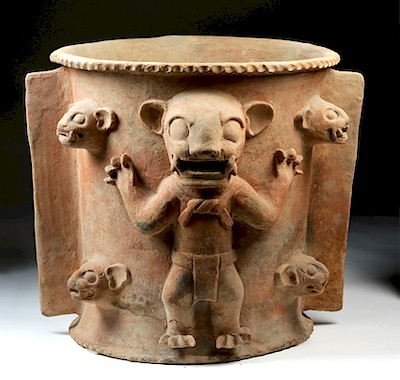Anasazi Tularosa Pottery Ladle - Black on White
Lot 162
About Seller
Artemis Fine Arts
686 S Taylor Ave, Ste 106
Louisville, CO 80027
United States
Selling antiquities, ancient and ethnographic art online since 1993, Artemis Gallery specializes in Classical Antiquities (Egyptian, Greek, Roman, Near Eastern), Asian, Pre-Columbian, African / Tribal / Oceanographic art. Our extensive inventory includes pottery, stone, metal, wood, glass and textil...Read more
Estimate:
$800 - $1,200
Absentee vs Live bid
Two ways to bid:
- Leave a max absentee bid and the platform will bid on your behalf up to your maximum bid during the live auction.
- Bid live during the auction and your bids will be submitted real-time to the auctioneer.
Bid Increments
| Price | Bid Increment |
|---|---|
| $0 | $25 |
| $300 | $50 |
| $1,000 | $100 |
| $2,000 | $250 |
| $5,000 | $500 |
| $10,000 | $1,000 |
| $20,000 | $2,500 |
| $50,000 | $5,000 |
| $100,000 | $10,000 |
| $200,000 | $20,000 |
About Auction
By Artemis Fine Arts
Dec 6, 2018
Set Reminder
2018-12-06 10:00:00
2018-12-06 10:00:00
America/New_York
Bidsquare
Bidsquare : DAY 2 : Pre-Columbian, Ethnographic & Fine Art
https://www.bidsquare.com/auctions/artemis-gallery/day-2-pre-columbian-ethnographic-fine-art-3699
Day 2 of an important 2-dy auction featuring ancient and ethnographic art from around the world. Today's sale will feature Pre-Columbian, Native American, African / Tribal, Ethnographic, Spanish Colonial, Fine Art, much more. Artemis Fine Arts info@artemisgallery.com
Day 2 of an important 2-dy auction featuring ancient and ethnographic art from around the world. Today's sale will feature Pre-Columbian, Native American, African / Tribal, Ethnographic, Spanish Colonial, Fine Art, much more. Artemis Fine Arts info@artemisgallery.com
- Lot Description
Native American, North America, southwest New Mexico, villages in southern Cibola Anasazi / Northern Mogollon, Ancestral Pueblo (Anasazi), ca. 1075 to 1250 CE. A lovely, hand-built pottery ladle which a lengthy handle and a deep scooping bowl, all covered in black-painted linear, stippled, and geometric motifs atop a smooth white ground. Made for stirring and serving foot, this example was probably deposited with a deceased member of the community or left in an abandoned domestic space. Size: 8" L x 4.25" W (20.3 cm x 10.8 cm).
Tularosa pottery from the Starkweather Ruin has been divided into three styles - Wingate, Snowflake and Tularosa - reflecting similarities in decoration with their source types. Classic Tularosa style designs are based on spirals, a diagnostic feature of the type. However, the spiral-stairstep motif is considered to be the most advanced development.
Many groups of indigenous peoples occupied the Tularosa region before the Apache drove them out in the 1800s. While some settled elsewhere, some groups completely disbanded. The Tularosa Basin in New Mexico was a rich source of Paleo Native American sites. Very little was known about the life of the Tularosa Basin; however, scholars have determined that the Anasazi and Mogollon peoples resided in the Tularosa Basin. The Anasazi culture existed from approximately 200 to 1300 CE, and their movement from the Tularosa Basin to the pueblos of the southwest has been identified. Tularosa is a village in Otero, New Mexico that shares its name with the Tularosa Basin where the town is located.
Provenance: private Boulder, Colorado, USA collection, acquired in Santa Fe, New Mexico, USA in 2018; ex-private Hammond collection, St. Johns, Arizona, USA
All items legal to buy/sell under U.S. Statute covering cultural patrimony Code 2600, CHAPTER 14, and are guaranteed to be as described or your money back.
A Certificate of Authenticity will accompany all winning bids.
We ship worldwide and handle all shipping in-house for your convenience.
#138169Large area of restoration to scoop bowl and handle reattached to scoop, with some resurfacing and overpainting along break lines. Minor nicks to scoop and handle, and light fading to white and black pigmentation. Light earthen deposits throughout.Condition
- Shipping Info
-
All shipping is handled in-house for your convenience. Your invoice from Artemis Gallery will include shipping calculation instructions. If in doubt, please inquire BEFORE bidding for estimated shipping costs for individual items.
-
- Buyer's Premium



 EUR
EUR CAD
CAD AUD
AUD GBP
GBP MXN
MXN HKD
HKD CNY
CNY MYR
MYR SEK
SEK SGD
SGD CHF
CHF THB
THB














